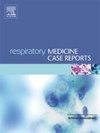罕见的肺多形性癌在计算机断层扫描上表现为几乎纯粹的磨玻璃结节:1例报告
IF 0.7
Q4 RESPIRATORY SYSTEM
引用次数: 0
摘要
多形性癌是一种罕见的非小细胞癌亚型,占所有肺部恶性肿瘤的0.1% - 0.4%,预后较差。瘤周磨玻璃结节(ggn)是一种常见的肿瘤,其病因多种多样,包括炎症、肺泡出血和腺癌。在这里,我们描述了一例女性患者在右上叶几乎纯粹的GGN。支气管镜活检证实了腺癌的诊断,这与成像观察到的低氟脱氧葡萄糖摄取一致。未发现淋巴结受累或远处转移,患者随后转介手术切除。行肺叶切除术并纵膈淋巴结清扫。手术标本的病理检查显示为鳞状腺癌,伴腺泡腺癌和小肉瘤样成分,诊断为多形性癌。免疫组织学分析显示,甲状腺转录因子-1和AE1/AE3在腺癌和肉瘤样成分中均呈阳性,而e -钙粘蛋白在肉瘤样成分中不表达。这些结果表明腺癌经历了上皮-间质转化,最终转化为肉瘤样成分。患者接受了尿嘧啶和替加富辅助化疗,术后存活10年无复发。多形性癌表现为几乎纯粹的GGN是非常罕见的,据我们所知,这是第一例报道的病例。我们的研究结果为EMT在肺部恶性肿瘤中的作用提供了见解。本文章由计算机程序翻译,如有差异,请以英文原文为准。
A rare case of pulmonary pleomorphic carcinoma presenting as a nearly pure ground-glass nodule on computed tomography: A case report
Pleomorphic carcinoma is a rare subtype of non-small cell cancer, accounting for 0.1 %–0.4 % of all pulmonary malignancies, and is associated with a poor prognosis. Peritumoral ground-glass nodules (GGNs) are commonly observed and have been attributed to various causes, including inflammation, alveolar hemorrhage, and adenocarcinoma. Here, we describe the case of a female patient with a nearly pure GGN in the right upper lobe. Bronchoscopic biopsy confirmed a diagnosis of adenocarcinoma, which was consistent with the low fluorodeoxyglucose uptake observed on imaging. No lymph node involvement or distant metastases were detected, and the patient was subsequently referred for surgical resection. Lobectomy with mediastinal lymph node dissection was performed. Pathological examination of the surgical specimen revealed a lepidic-dominant adenocarcinoma with areas of acinar adenocarcinoma and a small sarcomatoid component, leading to a diagnosis of pleomorphic carcinoma. Immunohistological analysis demonstrated thyroid transcription factor-1 and AE1/AE3 positivity in both the adenocarcinoma and sarcomatoid components, whereas E-cadherin expression was absent in the sarcomatoid component. These findings suggest that the adenocarcinoma underwent epithelial–mesenchymal transition, eventually transforming into a sarcomatoid component. The patient received uracil and tegafur as adjuvant chemotherapy and has survived for 10 years postoperatively without recurrence. Pleomorphic carcinoma presenting as a nearly pure GGN is exceedingly rare, and to the best of our knowledge, this is the first reported case. Our findings provide insights into the role of EMT in pulmonary malignancies.
求助全文
通过发布文献求助,成功后即可免费获取论文全文。
去求助
来源期刊

Respiratory Medicine Case Reports
RESPIRATORY SYSTEM-
CiteScore
2.10
自引率
0.00%
发文量
213
审稿时长
87 days
 求助内容:
求助内容: 应助结果提醒方式:
应助结果提醒方式:


